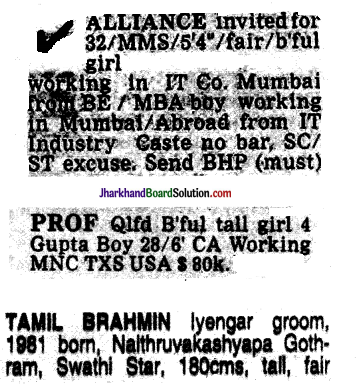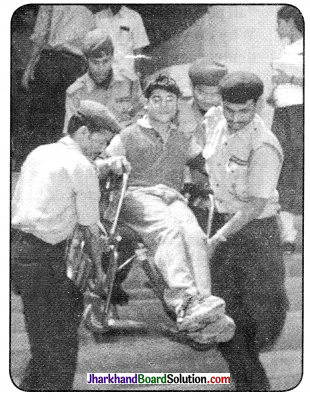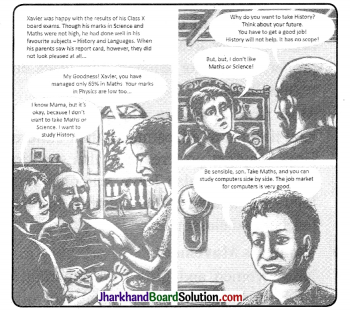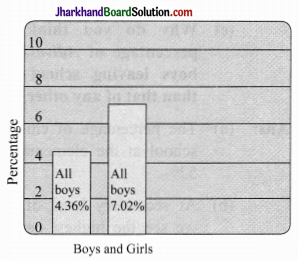JAC Board Class 7th Social Science Solutions Civics Chapter 6 Understanding Media
JAC Class 7th Civics Understanding Media InText Questions and Answers
Page 71
Question 1.
Look at the collage on the left and list six various kinds of media that you see.

Answer:
Six various kinds of media are:
- Newspaper
- Mobile phones
- Radio
- Television
- Internet
- Cyber Cafe
Question 2.
Ask older members of your family about what they used to listen to on the radio when there was no TV around. Find out from them when the first TV came to your area. When was cable TV introduced?
Answer:
The older member of the family used to listen news of national and international importance. Different types of programmes were also broadcasted such as on science, agriculture, entertainment etc. There were sports commentaries too but during the matches such as football commentary. Entertainment programmes were such as nataks or dramas, songs, kids play etc. The first television came to my place in the early 1980s and Cable TV was introduced in the year 1984.
Question 3.
How many people in your neighbourhood use the Internet?
Answer:
Almost everyone uses the Internet in my neighbourhood.
Question 4.
List three things that you know about some other part of the world from watching television.
Answer:
Three things that I know about some other part of the world from watching television are :
- Australian Open in Lawn Tennis was won by Novak Djokovic.
- Terrorist attack on the World Trade Centre in USA.
- Grammy Awards ceremony held in United States.
Page 72
Question 5.
Can you list three different products that are advertised during your favourite TV programme?
Answer:
Three different products that are advertised during my favourite TV programme are
- Colgate Toothpaste
- Maggi
- Suzuki Bikes
Question 6.
Take a newspaper and count the number of advertisements in it. Some people say that newspapers have too many advertisements. Do you think this is true and why?
Answer:
Yes, every newspaper contains lots of advertisements. A lot of money is spent on getting the latest and new technologies as the technology of mass media keeps changing. Due to these costs, mass media needs lots of money. Hence, this is one method to earn money by advertising various products like food items, shoes, accessories, cars, bikes etc.
Page 74
Question 7.
Are the above stories in the two newspapers similar? And if not, why not? What, in your view, are the similarities and the differences?
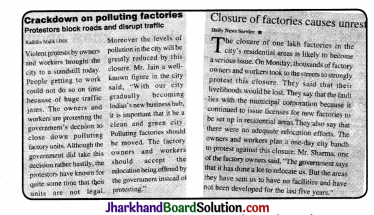
Answer:
No, the above stories in the two newspapers are not similar. In the News of India newspaper, the report is about the nuisance created by the protestors. They disrupted the traffic and continually polluted the city which gave a bad impression of the factories. Whereas, India Daily reports that they are protesting because a lot of livelihood will be lost if the factories shuts down.
| Similarities | Dissimilarities |
| In both the reports, the protestors were assured by the government that they will relocate the factories to some other place. | The News of India reports that closure of factories will give us neat, clean and green city. |
| Both the newspaper reports about the protests due to the factories shut down. | The India Daily reports that the closure of factories will give many loss of livlihoods. |
Question 8.
If you read the story in the News of India, what would you think about the issue?
Answer:
Since the government has taken a decision to close the factories which lead to pollution and it will reduce by the closure. But, the government’s decision infuriated and provoked the factory owners and the workers. The protest started due to this decision.
Page 75
Question 9.
Do you think it is important to know both sides of the story? Why?
Answer:
Yes, it is important to know both sides of the story because then only we will be able develop our own opinions and views about the story unbiasedly.
Question 10.
Pretend that you are a journalist for a newspaper and write a balanced story from the two news reports,
Answer:
Students need to do it on their own.
Page 77
Question 11.
What is the consequence of the media ‘setting the agenda’ by reporting on the Fashion Week rather than the slum demolitions?
Answer:
The consequence of the media ‘setting the agenda’ by reporting on the Fashion Week rather than the slum demolitions is that the media earns a good amount of money and fame as well.
Question 12.
Can you think of an issue that does not seem important to you because it is never featured in the media?
Answer:
An issue that does not seem important to you because it is never featured in the media is the price hike of the essential and daily use commodities.
JAC Class 7th Civics Understanding Media Textbook Questions and Answers
Question 1.
In what ways does the media play an important role in a democracy?
The media plays an important role in a democracy:
- The media provides news and discuss events taking place in the country and the world. It is on the basis of this information that people can get information about how government works.
- It also criticizes and depricate the unpopular policies and programmes of the government.
- On behalf of public, it forms the public opinion.
- It raises issues and problems related ‘ to common people.
- It also acts as reminder for the government about their promises.
Question 2.
Can you give this diagram a title? What do you understand about the link between media and big business from this diagram?

Answer:
The title we can give ‘Media and Giant Corporate Houses’. From this diagram it is clear that some big corporate and business houses have their own television channels and newspapers. They show news of interest to the people on television and newspaper and advertise their own product in between. To make money, independent media houses also advertise product of big business houses. As a result, most television channels and newspapers are part of big business houses. People are influenced by these advertisements to buy these advertised products of the big business houses and money flow back to them.
Question 3.
You have read about the ways in which the media ‘sets the agenda’. What kind of effect does this have in a democracy? Provide two examples to support your point of view.
Answer:
The media plays an important role in deciding what stories to emphasize on and decides on what is newsworthy. By emphasizing on particular issues and points, the media influences our thoughts, feelings and actions and brings those issues to our attention. Examples are:
- The media drew our attention to alarming levels of pesticides in cola drinks. They published reports that indicated the high level of pesticides, hence, according to international quality and safety standards we need to regularly monitor these colas and made us aware of the fact.
- The media drew our attention to suicide committed by farmers due to drought which leads to large scale movement and forced the government to look further on this issue.
Question 4.
As a class project, decide to fucns on a particular news topic and cut out stories from different newspapers on this. Also watch the coverage of this topic on TV news. Compare two newspapers and write down the similarity and differences in their reports. It might help to ask the following questions.
- What information is this article providing?
- What information is it leaving out?
- From whose point of view is the article being written?
- Whose point of view is being left out and why?
Answer:
Students need to do it on their own.
Question 5.
Do projects (solo, pair or group) about types of advertisements. Create commercial advertisements about some products and social advertisements about public health, road safety and the need to save water and energy.
Answer:
Students need to do it on their own.
JAC Class 7thCivics Understanding Media Important Questions and Answers
Multiple Choice Questions
Question 1.
The one word which includes television, radio, newspaper, books, internet and other means of communications is
(a) censorship
(b) media
(c) technology
(d) advertisements
Answer:
(b) media
Question 2.
An example of mass media is
(a) watching news on TV or listening songs in radio
(b) playing football with friends
(c) roaming in the city and eating delicious foods
(d) None of these
Answer:
(a) watching news on TV or listening songs in radio
Question 3.
The medium through which we get the picture in our television is
(a) mobile phones
(b) censorship
(c) satellite and cables
(d) public transport
Answer:
(c) satellite and cables
Question 4.
The Emergency Period was from
(a) 1965 to 1975
(b) 1975 to 1977
(c) 1970 to 1977
(d) 1985 to 1990
Answer:
(b) 1975 to 1977
Question 5.
The earliest form of mass media is
(a) print Media
(b) digital Media
(c) Both (a) and (b)
(d) Either (a) or (b)
Answer:
(a) print Media
Question 6.
…. is not a part of digital media.
(a) Television
(b) Internet
(c) Cellular Phones
(d) Books and magazines
Answer:
(d) Books and magazines
Question 7.
Prasar Bharti includes
(a) Doordarshan (Television)
(b) All India Radio
(c) Internet
(d) Both (a) and (b)
Answer:
(d) Both (a) and (b)
Question 8.
The Right to Information Act was passed on
(a) January, 2005
(b) May, 2008
(c) October, 2005
(d) July, 2002
Answer:
(a) January, 2005
Question 9.
Television was invented by
(a) Thomas Edison
(b) J.L. Baird
(c) Madam Curie
(d) Galileo
Answer:
(b) J.L. Baird
Question 10.
The newspapers which are published in Hindi is/are
(a) Punjab Kesari
(b) Hindustan
(c) Dainik Jagran
(d) All of these
Answer:
(d) All of these
Very Short Answer Type Questions
Question 1.
Do you think television influences us? How?
Answer:
Yes, television influences us. It shapes our views of the world, our beliefs, attitudes and values.
Question 2.
Why do yoir think newspapers are called print media?
Answer:
Newspapers are called print media because they are in printed form.
Question 3.
Give examples of local media.
Answer:
Examples of local media are Community Radio, Documentary Films, Local newspaper such as ‘KhabarLahriya’.
Question 4.
What do you mean by broadcast?
Answer:
Broadcast is used to refer to a television or radio programmes that are widely transmitted.
Question 5.
What do you understand by censorship?
Answer:
Censorship refers to the powers that government has to disallow or prevent media from publishing or showing certain stories.
Question 6.
Why we need to analyse the news?
Answer:
We need to analyze the news because the ‘factual information’ that a news report provides is often incomplete and can be one-sided.
Question 7.
Mention one way in which mass media earns money.
Answer:
One way in which the mass media earns money is by advertising different products such as cars, chocolates, clothes, mobile phones, etc.
Question 8.
Why are some advertisements shown repeatedly on the television screen?
Answer:
Advertisements are repeatedly shown on the television screen because these will influence the people and they will go out and buy what is advertised.
Question 9.
Is it necessary for media to be independent? Why?
Answer:
Yes, it is necessary for media to be independent because then only media can deliver a balanced report and information.
Question 10.
Which is the lighthouse of democracy?
Answer:
The media is lighthouse of democracy because it is the media who awares people about their rights. The government is criticised for its wrong doings by it. It also helps to maintain transparency.
Short Answer Type Questions
Question 1.
Television is known as a window of the world. How?
Answer:
Television is known as a window of the world because a lot of our impressions about the world around us are formed by what we see and listen on television.
Question 2.
List one useful feature about internet.
Answer:
One useful feature of internet is that we always get the latest information on internet as we can read latest news and gain knowledge about the latest products within minutes of their release.
Question 3.
What do you mean by public protest?
Answer:
Public protest is a type of protest when a large number of people come together and openly state their opposition to some issue. Organising a rally, starting a signature campaign, blocking roads, etc. are some of the ways in which public protest is done.
Question 4.
Define an independent media.
Answer:
An independent media means that no one should control and influence and affect its coverage of news. No one should tell the media what can be included and what should not be included in a news story. They should not be biased.
Question 5.
What do you understand by the term mass media?
Answer:
Television, radio and newspapers are a form of media that reaches millions of people or the masses across the country and the world are known as mass media.
Question 6.
Why do you think media is not interested in covering small issues that involve common people and their daily lives?
Answer:
Media is not interested in covering small issues that involve common people and their daily lives because these issues generally not attract many reader or viewer and may affect their business.
Question 7.
In what ways media and money are interrelated?
Answer:
The different technologies that mass media use are very costly and expensive. In a news studio, it is not only the newsreader who needs to be paid but also a number of other people who help put the broadcast together. The technologies that mass media use keep changing and hence lots of money is spent on getting the latest technology. Due to these costs, the mass media needs a great deal of money to do its work. So, we can say that media and money are interrelated.
Question 8.
Explain in brief that ‘Most television channels and newspapers are part of big business houses’.
Answer:
The statement ‘Most television channels and newspapers are part of big business houses’ is true. In a news studio, it is not only the newsreader who needs to be paid but also a number of other people who help put the broadcast together. This includes those who look after the cameras, lights, research people, etc. As you know that the technologies of mass media which is used keeps on changing and hence a lot of money is spent on getting the latest technology. Due to these costs, the mass media needs a great deal of money to do its work and the big business houses provide it.
Question 9.
In what ways, dees technology affect the media industry?
Answer:
Making technology more modem and advanced and changing technology or machines help media to reach more people. It also improves the quality of sound and the images that we hear and see. But technology does more than this. It also changes the ways in which we think about our lives. Now a days, it is quite difficult for us to think of our lives without television. Television has enabled us to think of ourselves as members of a larger global world. The world has come closer to us. Television images travel huge distances through satellites and cables which permits us to view news and entertainment channels from other parts of the world.
Long Answer Type Questions
Question 1.
Explain local media.
Answer:
Local media covers small and minute issues that involves common people and their daily lives. Several local groups have come forward to start their own media. Several people use community radio to tell farmers about the prices of different crops and advise them on the use of seeds and fertilisers. Other people make documentary films with very low budget and cheap and easily available video cameras on real-life conditions and problems faced by different poor communities.
At times, even they have given the poor people these video cameras to make films on their own lives. We can see an example. A newspaper called Khabar Lahriya which is a fortnightly that is run by eight Dalit women in Chitrakoot district in Uttar Pradesh. Written in the local language Bundeli. This eight-page newspaper reports on Dalit issues and cases of violence against women and political corruption.
Question 2.
In what ways we can say that media is. still not free to give unbiased and unprejudiced news and stories?
Answer:
We can say that media is still not free to give unbiased and unprejudiced news and stories mainly because of two reasons:
- The first one is that the government has the control on the media. When the government prevents and bans either a news item or scenes from a movie or the lyrics of a song from
being shared with the larger public this is referred to as censorship. There have been periods in Indian history when the government censored the media. - Second one is that at times, it is in the interest of these businesses to focus on only one side of the story. Media’s continual need for money and its connects to advertising means that it becomes difficult for media to be reporting against people who give them advertisements and money.
